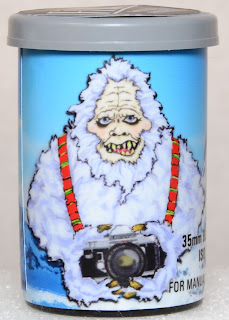Now available in the Film Photography Project Store, YETI is the latest in their "monster" film series. What is the story behind the YETI? I really don't know, but I think because the film is a glacially slow ISO 6, the YETI is the perfect "monster" to be the face on the film container. It could also be based on Mike Raso's expression as he sits in the FPP HQ during the cold winter months. However YETI arose, it's an interesting SLOW black and white film that is blue-sensitive (orthochromatic). The intended use for this film stock is in the cine world, where it was used for contact copying of titles and mats in motion pictures. It has a very fine grain, and nice tonality, and since it's blue-sensitive, it makes for an interesting film for portraiture. It should be shot in daylight for best results.
YETI comes in 24-exposure rolls, which is probably best for these unusual films. It has a PET (Estar) plastic base, so it light-pipes like crazy. Store it in black plastic film cans and load in subdued light. My experience with it has shown me that loading in direct sunlight is a real no-no. So, load the film into your camera indoors, if possible. Since it has an ISO of 6, you can only use this film in an SLR or a rangefinder camera where you can manually set the shutter speed/aperture/ISO. Automatic cameras, such as point and shoots cannot be used with these low-ISO films. If your camera can't go down to ISO 6, there are several ways to determine the correct exposure. If your camera's ISO dial only goes to 25, and you have an exposure compensation dial, set it to +2 stops. If there is no compensation dial, you'll have to manually compensate in the exposure. You can use a light-meter app on your phone to determine the exposure if you want to go full manual. You can also try sunny-16 if you wish, as follows:
full sun at f/16, ISO 6 = 1/6 sec , therefore f/11= 1/12 sec (1/15); f/8= 1/25, f/5.6= 1/50, f/4= 1/100 sec f/2.8= 1/200 sec., f/1.4 = 1/500 sec.
That's for full sun. Make the appropriate changes for cloudy conditions, etc. So, on a sunny or cloudy-bright day, you can shoot this film hand-held at wide apertures. On any other conditions, a tripod is recommended.
My favorite camera with these slow films is my F100 or my F4, since ISO 6 is available as a setting. That's because I'm lazy and don't like to extrapolate in my head with cameras that can't go that low, and since I like aperture-priority, it all works smoothly with my chosen cameras. I used my Nikon F3HP for the first roll, and as the ISO setting only goes to 12, I used +1 to +1.5 for the shots (compensating more when the subject was bright water). An external light-meter that can go to ISO 6 is not that common, but my iPhone light meter app goes to ISO 1. Shooting films like YETI wide open on a sunny day gives you some creative possibilities that you just won't get with normal films.
Orthochromatic films are also a different experience to shoot with, vs panchromatic films. A blue-sensitive film means that reds will register as dark tones, so skin will be darker, and blue skies very light. Again, slow and orthochromatic will be somewhat like shooting film in the late 1800s. A definite creative opportunity!
YETI is one of the films that you really ought to try out. It develops easily in common developers, and unlike some high-contrast slow films, it has a normal tonality that does not require the use of special developers to achieve proper contrast.
I shot YETI film in situations that I might normally encounter, and I'm pretty happy with how they turned out. I definitely will be shooting some urban scenes with it soon, now that spring has arrived and I'm exploring more in my area.
I developed my YETI in D76 1:1 for 11 minutes for the first roll (images 1-3 below) and the second roll in D-96 for 7.5 minutes at 20°C for the last three images.
Some examples from the two rolls that I shot.









1 comment:
Nice sample photos Mark - I am happy to see the skin tones look so natural as you might expect them to be a bit darker.
Post a Comment